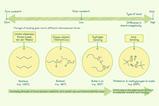Ensure students learn from their video viewing with these four effective strategies

Practical work is an integral part of chemistry, supporting student engagement and learning in the classroom. Videos can be used to enhance the practical experience in the lab and are a good alternative when it is not possible for students to do experiments themselves, for example during remote teaching. The Practical assessment in school science (PASS) project from King’s College London and the University of York supports the idea that a demonstration with quality interaction between the teacher and students benefits learners. And we can build on this in the classroom.
So how do we make the most of these video demonstrations? Start with these four easy-to-implement strategies, whether you’re in school or remote teaching.
1. Imitate a teacher demonstration
When showing a video, mute the audio and do your own narration. This immediately increases the level of interaction with your students. But to do this, you need to be really familiar with the video before the lesson.
Regularly pause the video to ask questions; these are often called pause-and-think questions. This will keep the class engaged and also provide you with feedback about their understanding. Use a variety of questions based around subject content or scientific process. When asking a closed question – such as ‘name this piece of equipment’ or ‘write down the reactants, products or equation’ – get students to respond by writing answers on mini-whiteboards (or your remote teaching platform) to increase participation.
Give students an opportunity to test their understanding of key points about the experimental observations against your own expert view.
It’s important to ask the questions verbally and not just provide a worksheet to do in silence while they watch as this greatly increases cognitive load. When asking students to fill out a worksheet, pause the video and give them thinking time.
2. Follow a free view with a focused view
This activity promotes interest and engagement, as well as developing scientific language. Students watch the video and then talk through what they have seen and ask their own questions. After this, they then answer specific questions as they rewatch the video.
This strategy comes from the Learning Skills for Science package; skill area 2, which offers teacher notes and student worksheets to download.
This strategy comes from the Learning Skills for Science package; skill area 2, which offers teacher notes and student worksheets to download: LINK.
3. Flip learning
Videos can be used effectively as part of a flipped learning approach. Ask students to view the video ahead of the live practical lesson, at home or in a previous lesson. This gives them the opportunity to get familiar with the equipment and method before they arrive in the practical lesson. It will also help the activity to run more smoothly and keep objectives in focus, as well as help to build their confidence. During the first view, give student questions to answer. This can help engagement during the lesson.
4. Consolidate and revise
There is also value in students watching the video after the practical, either directly after the lesson or later as part of their revision. The video can support their write-up of the practical or help them answer extended response questions from a follow-up worksheet, for example.
Choose your view carefully
These strategies all rely on good quality videos. Always watch the video before sharing it with students.
The RSC has collated practical videos for the 16–18 age group and 14–16 students. The latter includes six practical experiments, covering conservation of mass, electrolysis of aqueous solutions, halogen displacement reactions, reactivity of metals, identifying ions and preparing a soluble salt. They come with everything you need to use the above strategies: teacher and technician notes, pause and think questions, integrated instructions and student practical skills worksheets.
The PASS project
The Practical assessment in school science (PASS) began in March 2018 and concludes in August 2021. The researchers taught six different practical activities to groups of students (aged 14–15) using different interventions including a hands-on experiment, a teacher demonstration, watching a video, and reading a written description.
The researchers found that experiencing a teacher demonstration of an experiment led to significantly higher scores in practically-oriented questions than just reading about the experiment or watching a video. However, there was no statistically significant difference between the teacher demonstration intervention and the hands-on practical intervention. They concluded that this result was due to the quality of the interaction between teacher and students while carrying out a demonstration.
This interim report also considers the effect of practical work during the pandemic.














1 Reader's comment